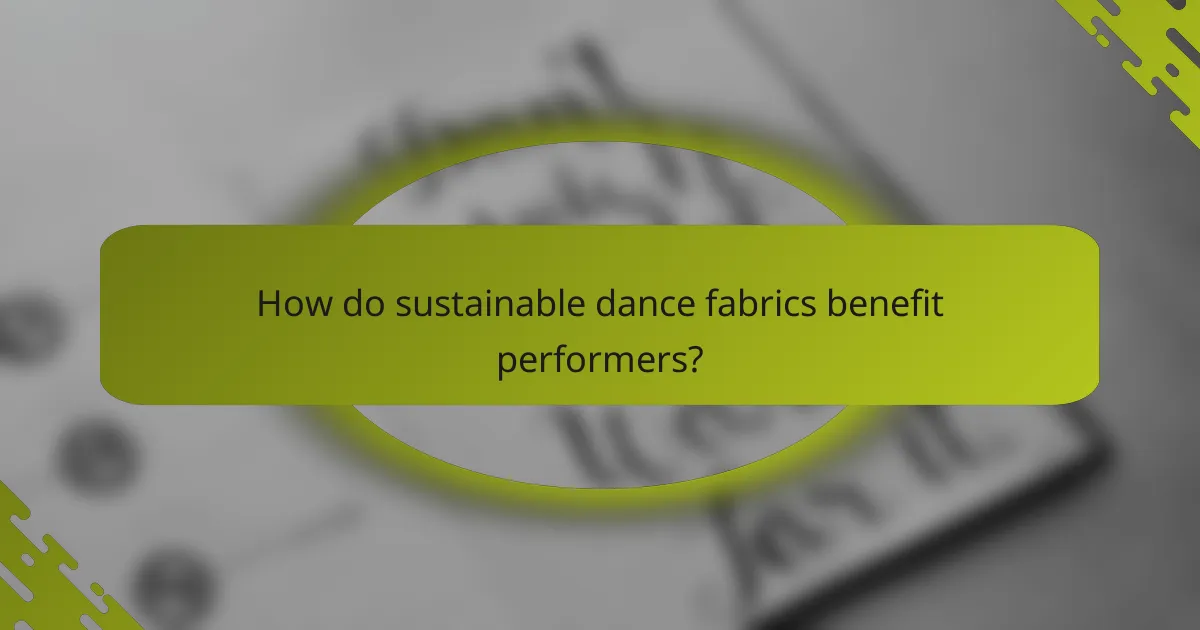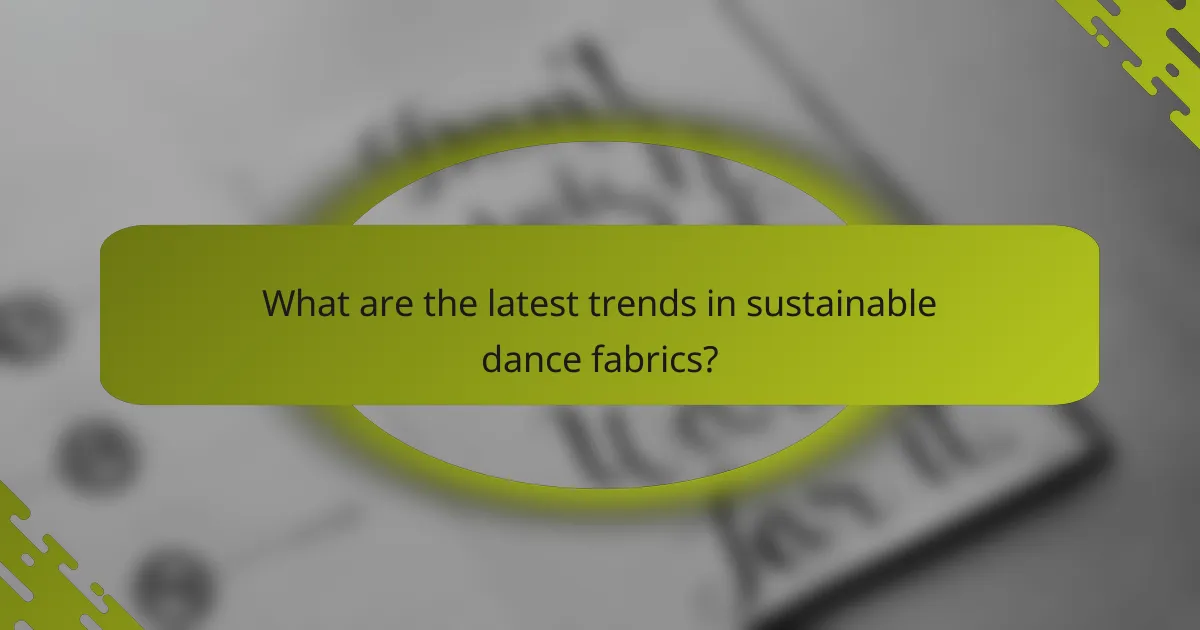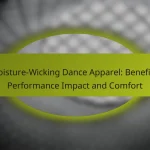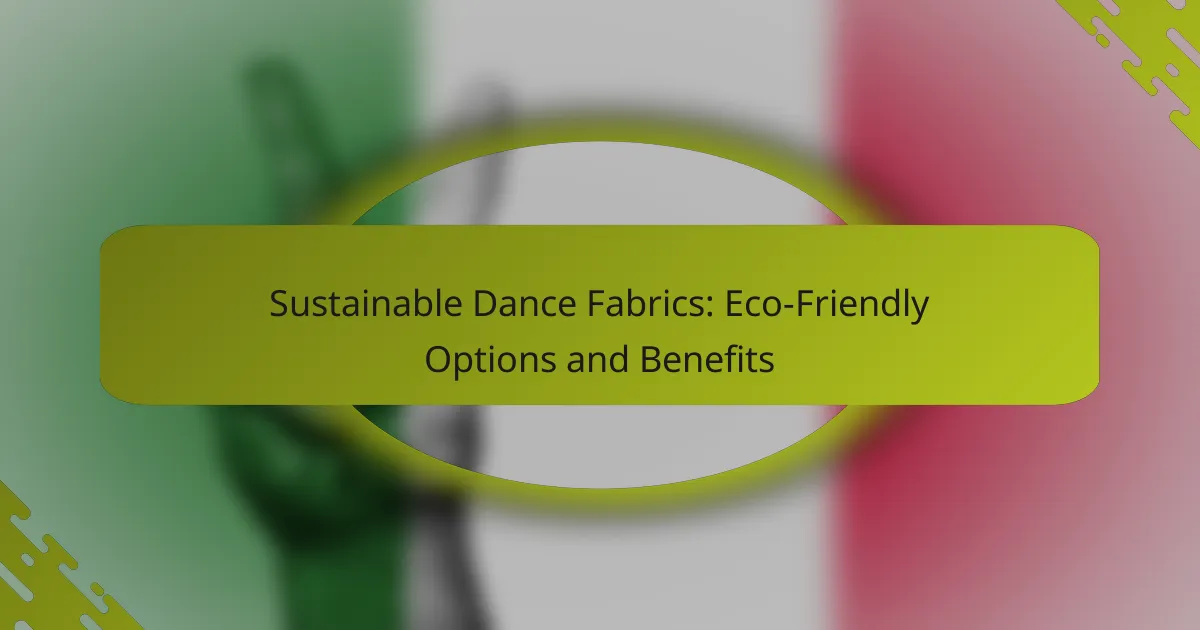Sustainable dance fabrics, such as organic cotton, bamboo, recycled polyester, Tencel, and hemp, provide eco-friendly options that prioritize both performance and comfort for dancers. By opting for these materials, performers not only enhance their experience but also contribute to a healthier planet through reduced environmental impact. Accessible through various online retailers and specialty shops, these fabrics offer a range of selections to meet diverse needs.

What are the best eco-friendly dance fabrics?
The best eco-friendly dance fabrics include organic cotton, bamboo fabric, recycled polyester, Tencel, and hemp fabric. These materials are not only sustainable but also offer comfort and performance for dancers.
Organic cotton
Organic cotton is grown without synthetic pesticides or fertilizers, making it a safer choice for both the environment and the farmers. It is soft, breathable, and highly absorbent, which is ideal for dancewear that requires flexibility and comfort.
When selecting organic cotton fabrics, look for certifications like GOTS (Global Organic Textile Standard) to ensure the material meets strict environmental and social criteria. This fabric is a great choice for those who prioritize sustainability in their dance attire.
Bamboo fabric
Bamboo fabric is derived from the fast-growing bamboo plant, which requires minimal water and no pesticides. This fabric is naturally moisture-wicking and antibacterial, making it suitable for intense dance sessions.
Consider bamboo blends for added durability and stretch. While bamboo is eco-friendly, ensure that the manufacturing process is sustainable, as some methods can involve harmful chemicals.
Recycled polyester
Recycled polyester is made from post-consumer plastic bottles and other plastic waste, reducing landfill contributions and resource consumption. This fabric is durable, lightweight, and retains its shape well, making it popular for activewear.
When choosing recycled polyester, check for certifications like the Global Recycled Standard (GRS) to verify the material’s sustainability. This option is ideal for dancers looking for performance fabrics with a lower environmental impact.
Tencel
Tencel, or lyocell, is produced from sustainably sourced wood pulp, primarily from eucalyptus trees. The manufacturing process uses a closed-loop system that recycles water and solvents, minimizing waste and pollution.
This fabric is soft, breathable, and has excellent moisture management properties, making it comfortable for dance. Tencel is biodegradable, adding to its eco-friendly appeal.
Hemp fabric
Hemp fabric is made from the stalks of the hemp plant, which grows quickly and requires little water and no pesticides. It is known for its strength, durability, and breathability, making it a practical choice for dancewear.
Hemp can be blended with other fibers for added softness and flexibility. When selecting hemp fabrics, look for those that are certified organic to ensure sustainable practices were followed during cultivation and processing.

How do sustainable dance fabrics benefit performers?
Sustainable dance fabrics provide numerous advantages for performers, including enhanced comfort, improved durability, and a lower environmental footprint. By choosing eco-friendly materials, dancers can enjoy better performance while contributing to a healthier planet.
Comfort and breathability
Sustainable dance fabrics are often made from natural or recycled fibers that promote comfort and breathability. Materials such as organic cotton, bamboo, and hemp allow for better air circulation, keeping dancers cool during performances and rehearsals.
Additionally, these fabrics typically have moisture-wicking properties, which help to manage sweat and prevent discomfort. This is especially important for dancers who engage in intense routines, as staying dry can significantly enhance performance quality.
Durability and longevity
Many sustainable dance fabrics are designed to withstand the rigors of regular use, offering excellent durability and longevity. Fabrics made from recycled polyester or nylon can resist wear and tear, ensuring that dancewear lasts longer than conventional options.
Investing in high-quality, sustainable materials can save dancers money over time, as they will not need to replace their clothing as frequently. This durability is crucial for performers who rely on their attire to maintain a professional appearance during shows.
Reduced environmental impact
Choosing sustainable dance fabrics significantly reduces the environmental impact associated with traditional textile production. Eco-friendly materials often require less water and energy to produce, and many are sourced from renewable resources.
Furthermore, opting for fabrics that are biodegradable or made from recycled materials helps minimize waste in landfills. Dancers can feel good about their choices, knowing they are supporting sustainable practices that benefit the planet.

Where can I buy sustainable dance fabrics in the US?
You can find sustainable dance fabrics in the US through various online retailers, local fabric stores, and specialty dance shops. Each option offers unique selections and price ranges, making it easier to find eco-friendly materials that suit your needs.
Online retailers like EcoVogue
Online retailers such as EcoVogue specialize in sustainable dance fabrics, offering a wide variety of eco-friendly options. These platforms often provide detailed descriptions of the materials used, including organic cotton, recycled polyester, and bamboo blends.
Shopping online allows you to compare prices and styles easily. Look for retailers that offer free shipping or returns to make your purchase more convenient.
Local fabric stores in New York
New York boasts several local fabric stores that carry sustainable dance fabrics. Stores like Mood Fabrics and Fabric Outlet often stock eco-friendly materials sourced from local and international suppliers.
Visiting these stores allows you to feel the fabrics and see the colors in person, which can be beneficial when selecting materials for specific dance costumes. Check for any local events or workshops that may highlight sustainable practices in fabric sourcing.
Specialty dance shops
Specialty dance shops often carry a curated selection of sustainable dance fabrics tailored for performance wear. These shops understand the specific needs of dancers and may offer fabrics that provide both durability and comfort.
When shopping at these stores, inquire about the sourcing of their materials and any certifications they may have. This ensures that you are purchasing from a retailer committed to sustainability.

What should I consider when choosing sustainable dance fabrics?
When selecting sustainable dance fabrics, prioritize eco-friendly materials, ethical production methods, and overall cost-effectiveness. Understanding these factors will help you make informed choices that align with your values and performance needs.
Fabric composition
Fabric composition is crucial in determining the sustainability of dance materials. Look for fabrics made from organic cotton, recycled polyester, or Tencel, which are known for their lower environmental impact. Avoid synthetic fibers derived from petroleum, as they contribute to pollution and are not biodegradable.
Additionally, consider the certifications of the fabrics, such as Global Organic Textile Standard (GOTS) or OEKO-TEX, which ensure that the materials meet specific environmental and safety standards.
Production practices
Production practices significantly affect the sustainability of dance fabrics. Opt for brands that prioritize ethical labor practices, use renewable energy, and minimize water usage in their manufacturing processes. Transparency in supply chains is essential; look for companies that openly share their production methods and sourcing.
Support local manufacturers when possible, as this can reduce carbon footprints associated with transportation and promote local economies. Certifications like Fair Trade can also indicate responsible production practices.
Cost and availability
Cost and availability are practical considerations when choosing sustainable dance fabrics. Eco-friendly options may initially be more expensive than conventional fabrics, but their durability and performance can lead to long-term savings. Expect to pay anywhere from 10% to 50% more for sustainable materials, depending on the brand and fabric type.
Availability can vary by region, so research local suppliers or online retailers specializing in sustainable fabrics. Many brands now offer a range of options, making it easier to find suitable materials that fit your budget and performance requirements.

How do sustainable dance fabrics compare to traditional options?
Sustainable dance fabrics generally have a lower environmental impact than traditional options, focusing on eco-friendly materials and production methods. While they may vary in performance and price, they offer dancers a responsible choice without sacrificing quality.
Environmental impact differences
Sustainable dance fabrics are often made from organic, recycled, or biodegradable materials, significantly reducing pollution and waste compared to conventional fabrics. Traditional options typically rely on petroleum-based fibers, which contribute to environmental degradation during production and disposal.
Many sustainable fabrics adhere to certifications like Global Organic Textile Standard (GOTS) or OEKO-TEX, ensuring that they meet specific environmental and social criteria. Choosing these certified options can help dancers support more responsible manufacturing practices.
Performance characteristics
While sustainable dance fabrics can match the performance of traditional materials, some may have unique qualities. For instance, fabrics made from bamboo or recycled polyester often provide excellent moisture-wicking properties and breathability, enhancing comfort during dance.
However, it’s essential to test different sustainable options, as some may not have the same stretch or durability as synthetic alternatives. Dancers should consider their specific needs, such as flexibility and support, when selecting fabrics.
Price comparison
The price of sustainable dance fabrics can vary widely, often ranging from slightly higher to significantly more than traditional options. Factors influencing cost include the type of material, production methods, and brand reputation.
While some sustainable fabrics may be pricier upfront, they can offer long-term value through durability and reduced environmental impact. Dancers should weigh the initial investment against the benefits of supporting sustainable practices in the dance industry.

What are the latest trends in sustainable dance fabrics?
The latest trends in sustainable dance fabrics focus on eco-friendly materials that minimize environmental impact while providing comfort and performance. Innovations include fabrics made from recycled plastics, organic cotton, and biodegradable fibers, catering to the growing demand for sustainability in the dance community.
Recycled Materials
Recycled materials are increasingly popular in sustainable dance fabrics, with options like recycled polyester derived from plastic bottles. These fabrics not only reduce waste but also require less energy to produce compared to virgin materials. Dancers can find garments that combine style and sustainability, often featuring vibrant colors and unique textures.
Organic and Natural Fibers
Organic cotton and natural fibers such as bamboo and hemp are gaining traction for their minimal environmental footprint. Organic cotton is grown without harmful pesticides or fertilizers, making it safer for both the planet and the wearer. Bamboo and hemp fabrics are naturally breathable and moisture-wicking, ideal for intense dance sessions.
Biodegradable Options
Biodegradable fabrics, such as those made from Tencel or other plant-based materials, are emerging as a sustainable choice for dancers. These fabrics break down naturally after disposal, reducing landfill waste. When selecting biodegradable options, look for certifications that ensure the materials meet environmental standards.
Performance and Comfort
While sustainability is crucial, performance and comfort remain top priorities for dancers. Many sustainable fabrics are engineered to provide stretch, breathability, and moisture management, ensuring that dancers can move freely. It’s essential to test the fabric’s feel and fit to ensure it meets personal performance needs.
Choosing Sustainable Brands
When shopping for sustainable dance fabrics, consider brands that prioritize eco-friendly practices. Look for certifications like Global Organic Textile Standard (GOTS) or OEKO-TEX, which indicate adherence to environmental and social standards. Supporting these brands not only benefits the environment but also encourages more companies to adopt sustainable practices.










